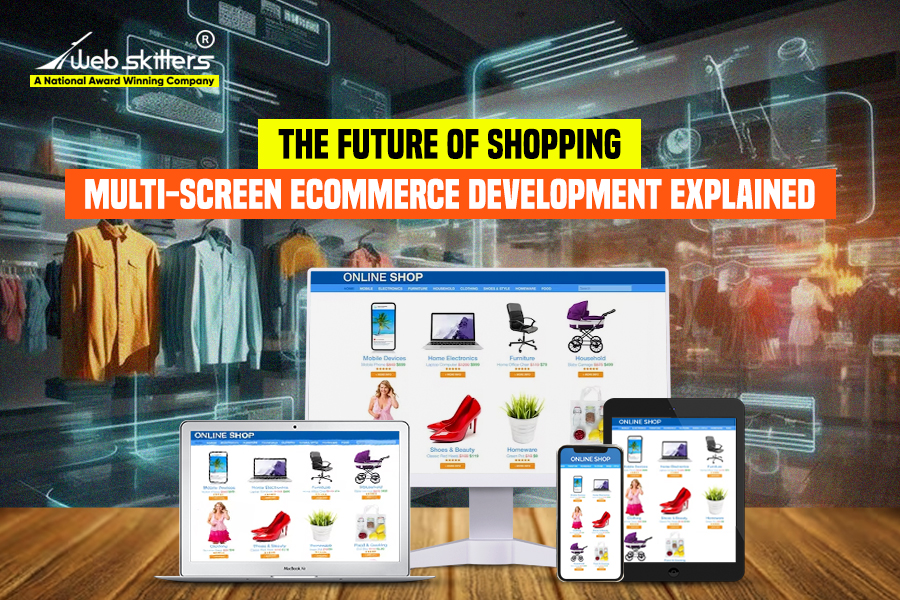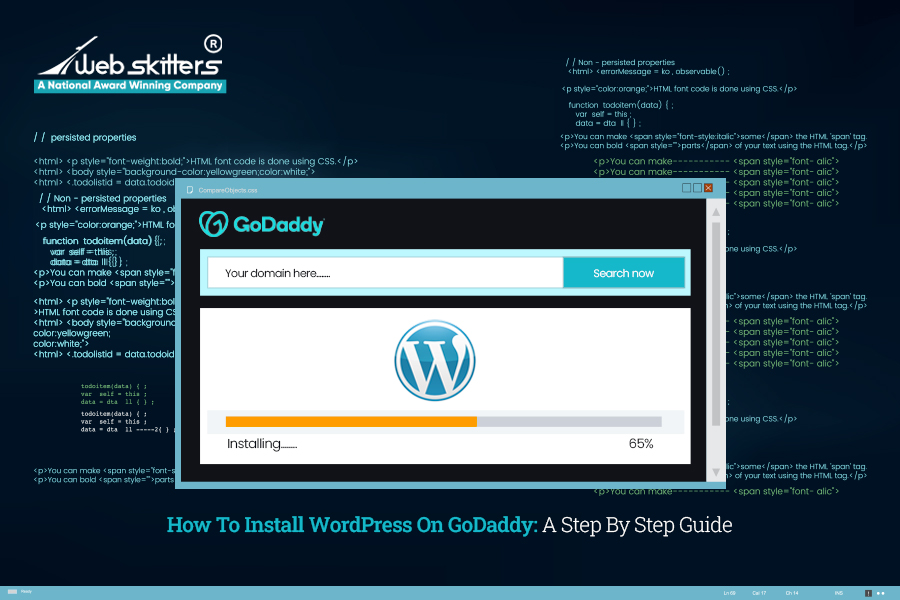Through massive technological evolution, we have become a nation of multi-screeners. We scroll through our Smartphones while watching the television. Sometimes, we watch a movie on a laptop while learning about it on the Smartphone. While shopping online, we tend to switch from one device to another to analyze the same product.
Google surveyed that 67% of online shoppers begin their journey on their Smartphone and complete it on a laptop. The device a user chooses to scroll on is driven by the context – place, action in mind, the time at hand, etc.
For instance, a middle-aged man looking forward to shopping for an engagement ring finds one of choice online while on the street. Data suggests he would head back home and complete the purchase from his laptop when in a comfortable position.
This multi-screen consumer behavior study by Google concluded that this is the norm. It has become imperative for e-commerce to revamp strategies that meet multi-screen needs.
In this digital era, an average multi-screener spends 4.4 hours on a screen. It includes retail-focused scrolling. During these 4 hours, they pass through several purchase points – junctures that trigger conversion.
It is pivotal for your e-commerce store to offer experiences that compel them to convert at these specific points.
The future of e-commerce lies in crafting multi-screen strategies to meet consumers’ Omni-channel retail behavior.
In this blog, we will provide a comprehensive guide to establishing a multi-screen ecommerce development.
We will discuss future-proof strategies and the various dos and don’ts. We will cover the following topics as we go:
- The basics of Multi-Screen E-commerce
- The current state of e-commerce
- Benefits of multi-screen e-commerce
- Components multi-screen e-commerce development
- E-commerce future trends
- Multi-screen e-commerce strategies
The goal of this blog is to ensure your e-commerce business successfully thrives on multiple technological devices.
Understanding Multi-Screen E-commerce
Multi-screening refers to sequentially using two or more devices to perform similar or related tasks. It could mean a tablet and a Smartphone, or a laptop involved. In multi-screen e-commerce, users utilize multiple screens to analyze desirable products and make a purchase.
It is often almost not predictable, where the user is likely to end their shopping journey. However, Google’s consumer behavior study has concluded the following:
- 65% start on a Smartphone > 61% continue on a laptop > 4% continue on a tablet
- 25% start on a laptop > 19% continue on a Smartphone > 5% continue on a tablet
- 11% start on a tablet > 10% continue on a laptop
90% of online interactions are based on this, and the behavior has been termed convenience of choice.
This consumer behavior has made it crucial for e-commerce businesses to build multi-screen responsive stores. Owing to the present ecommerce dynamic – being only mobile-friendly, will not cut for digital success.
There are two modes of multiple screening behaviors at large –
- Sequential Usage – Switching from one device to the other to complete a retail journey.
- Simultaneous Usage – Using two or more devices at the same time for related or unrelated online activity.
Sequential usage is the most common in e-commerce, and in the majority of cases starts with Smartphones.
The retail dynamic is evolving concerning multi-screen consumer behavior. With 268 million online shoppers in the United States, it is only rational for businesses to develop multi-screen e-commerce strategies.
The Current State of E-commerce
The US e-commerce market is the second largest after China. The yearly retail sales are close to a trillion with a growth rate of 10%. During the pandemic, the market was tumultuous with a massive sales spike of 36%.
Currently, the market has settled, and the growth rate has normalized. It is expected to register a 14.7% CAGR by the year 2027.
Retail sales have been growing rapidly, and the present revenue is $925 billion (about $2,800 per person in the US)
Amazon is the most popular e-commerce site with $356 billion in e-commerce sales in 2022. The other market mammoths following Amazon are Walmart, Apple, eBay, Target, etc.
As we speak, the US retail market has a few challenges at hand – e-commerce security, targeted audience, customer loyalty, and conversions, to name a few.
Here’s a better understanding of each
- E-commerce handles an enormous amount of data, and any technical issue leading to a security breach will wreak havoc on retailers and consumers.
- Identity theft in the retail industry has become a norm; the focus is on enhancing online identity verification.
- Retaining customers effectively through loyalty programs, since grabbing new customers costs 5x more.
- Visitors are not turning into customers, and this is a major challenge looming over the industry. This translates to multiple things – not the right targeted audience, below-par user experience, and not-so-competitive pricing.
Benefits of Multi-Screen E-commerce
Multi-screen e-commerce tackles digital consumers with a forward-thinking approach. It caters to multi-screeners in diverse ways. Whether a user is scrolling through deals on their Smartphone or completing the checkout on their laptop, it’s all part of one seamless multi-screen adventure.
The multi-screen approach minimizes friction in the consumer journey, enhancing satisfaction and enabling brand loyalty. The responsive design inherent in multi-screen e-commerce strategy adapts to various screen sizes and resolutions.
The goal is to deliver a visually appealing and functional interface across devices. The adaptability streamlines the user experience and positions businesses as tech-savvy and attuned to the modern consumer.
The flexibility to browse and shop from different devices provides users with the freedom to interact with a brand on their terms. This adaptability extends beyond device type, encompassing multiple operating systems and browsers, ensuring a seamless experience for a diverse audience.
For businesses, this translates to tapping into improved e-commerce objectives
- Increased accessibility and broader customer reach
- Successful online presence to users across various devices
- Access to new markets and demographics, amplifying their online presence
- Engaging with consumers at different touch points in their daily lives enhances conversion possibilities.
- Positioning the brand as accessible and customer-centric.
- Future-proofing e-commerce businesses by revamping digital strategies.
Implementation of a multi-screen e-commerce approach opens up avenues for expanded market penetration. Companies that have embraced this strategy effectively respond to changing consumer behaviors and preferences.
For instance, a brand may leverage social media platforms for mobile engagement, a dedicated app for personalized experiences, and a responsive desktop website for comprehensive product exploration.
With multi-screen, a business can be in all those places at once.
Big players like Amazon are nailing this game. They’re everywhere – on the web, in apps, even in your voice assistant. It’s all about being where the customers are.
Key Components of Multi-Screen Ecommerce Development
The ideal goal of a multi-screen e-commerce strategy is to provide users the freedom of converting or completing a purchase in any technological medium. The content they interact with on your website must offer a similar experience when switching to a tablet.
Here are the key components to keep in mind when building such a strategy
- Designing a Responsive Website
Users engage most with a website when it is navigable, readable, and usable. No matter what device they are in, the brand offers the same user experience. To shoppers, this is a helpful feature that adds credibility and increases the chances of conversion.
Google reported that 61% of users are likely to abandon a website if they have trouble accessing it through mobile phones. 40% of them end up converting to a competitor website.
Hence, thriving in the multi-screen e-commerce era requires website designs to be responsive to multiple devices.
There are several features to get inspired from other such applications. For instance, Pinterest offers a highly responsive website and app experience. The pinning feature allows you to save useful content across mediums to access later – app, desktop app, or website.
(It is recommended to hire professionals when building a responsive e-commerce website design)
- Cross-device compatibility
Cross-device compatibility and responsiveness go hand in hand in a multi-screen strategy. It ensures the website or app functions effectively across devices and browsers without compromising the UI and UX.
Cross-device compatibility also ensures a synced behavior. The user behavior is synced, and they can resume exactly where it stopped before the device switch.
Amazon effectively utilized this feature. Post searching for a product on the Amazon app and switching to a laptop, the website takes you back to searches through ‘continue shopping’, or ‘last viewed’.
- Offering a Mobile App
As aforementioned, daily media interactions begin on a Smartphone. These have the highest number of user interactions per day, and in a multi-screen environment, the first interaction juncture.
The app you provide to your users must be related to your e-commerce website. It must be informative and educate visitors about your brand and the products available. Like the website, the app must be responsive and thoroughly synced to the website for maximum user experience.
- Focusing on Content Optimization
Optimized content design, including text, typography, and images, are essential components of a responsive e-commerce website or app. When trying to rule the e-commerce multi-screen market, the objective must be delivering an optimized experience.
Starting from right-sized images to adaptable content frames, all contribute to the user experience.
Flexible media is an essential component of content responsiveness. It makes images, content blocks, and other formats fluid. The size changes accordingly with the viewport of the website or app.
- Offering Complementary Technology
Another added feature to strengthen the multi-screen e-commerce strategy is offering complementary technology. This could be anything – from an email to a follow-up text. Several e-commerce retailers focus on collecting contact information from visitors for further engagement. It keeps an opportunity open for brands to reconnect with their potential customers.
The reason is simple – with so many screens and brands available, users completely forget their buyer journey. They do not run to competitors; they simply forget they were looking for such an item.
Complementary technology serves as a subtle reminder to these audiences and brings them back to the conversion path.
Some added tips for Multi-Screen e-commerce development
- Avoid using separate domains for separate versions of the website; this confuses users and reduces the credibility effect.
- Increase content consumption by offering valuable and responsive content. It includes detailed product descriptions, blogs, and guides.
- 58% of users prefer brands that remember their past behavior reports HubSpot. Focus on thorough syncing of user persona across devices.
- Do not hide content when trying to make the website mobile-friendly. A user would rather experience horizontal scroll than hidden content.
Importance of Analytics in Multi-Screen E-commerce Strategy – To ensure the above components have the desired result in the e-commerce strategy, it is important to leverage analytics and user-tracking. Analytics and tracking allow businesses to study how users interact with their websites. It ‘to the point’ delivers time frames – when a user drops using the website version and turns to the mobile device. It also indicates the engagement time on each device.
Accordingly, brands can implement strategies to elevate screen time and offer conversion possibilities across interaction junctures. Without analytics and tracking, planning is futile in e-commerce.
Multi-Screen E-commerce Challenges and Solutions
Since multi-screen e-commerce is no longer an ‘add-on’ but a necessity, let us quickly get into the various challenges the strategy is likely to face.
- Meeting User Expectations – In a sequential usage pattern, users switch to and from multiple devices in a single e-commerce journey. They expect a similar user experience, across all devices.
Although this high expectation can appear to be a potential problem, the solution lies within the components of multi-screen e-commerce.
Businesses must focus on offering a responsive design structure to their online presence across devices. They must enable customers to save their progress or some feature to resume the journey post-device switch.
- Retaining Customers to the Journey – The device on which the user switches is dependent on convenience. And sometimes, there are huge gaps between these switches. Some percentage of these visitors never return to the shopping.
The solution? Using complementary technologies and marketing tactics for customer retention. This could be reminding visitors of their shopping journey through text messaging or email.
- Catering to Marketing Needs – The multi-screen world is a great opportunity to utilize digital marketing and expand consumer reach. However, the escalation in the number of devices would demand multiple marketing campaigns.
Digital marketers will have to maintain consistency and connectivity to utilize marketing effectively. Even though this does not seem like a problem, the major issue lies in the marketing budget.
Performing multi-screen digital marketing would require a massive budget and may not be preferable for several businesses.
A simple solution would be focusing on SEO and content and prioritizing UGC until a healthy marketing budget is decided.
Several brands have faced these e-commerce challenges and brainstormed innovations. From advanced marketing to complimentary tech, they have utilized them all to break through the struggles. The goal is to learn from these e-commerce giants what the future of digital retail demands.
Future Trends and Innovations in Multi-Screen E-commerce
Staying updated about multi-screen trends and e-commerce practices is essential to stay ahead in the digital landscape in the coming years. To help brands like yours gear up for the upcoming year, we have listed some emerging trends to watch out for.
Collated with multi-screen features, these e-commerce trends will be game-changing in revenue and conversion –
- Voice-enabled search – We are avid online shoppers in real life, and must have come across voice-enabled search at some point. Amazon Alexa and Google Home are the perfect examples to demonstrate.
If not implemented already, for retailers this is the next trend in line. Optimizing websites, apps, and other multi-screens with voice search means enhancing the platforms with conversational keywords.
Recent voice search statistics, claim voice search-enabled sales are to exceed $30 billion by 2024. Hence, prepping for voice search e-commerce is a smart move.
- The AR and VR Revolution – Not that these two haven’t already penetrated the market, AR and VR will keep up their pace in the 2024 e-commerce market. It will soon become a norm for big to small e-commerce companies.
AR and VR together take user experience to the next level, and topping it over with multi-screen features makes brands high-converting.
By 2025, AR and VR will combine with multi-screen strategies to heighten e-commerce potential.
- Automation and Chatbot Orders – Dominos takes their orders through its messenger chatbot Dom. With such a feature to simplify food orders, the brand is already ahead of its competitors. This feature makes sense for any e-commerce business, including yours.
- Machine Learning and AI – A major part of multi-screen e-commerce development is market research. With AI and machine learning, this takes a step ahead.
Netflix, for instance, has 1300 taste communities. Using AI and market research, the platform has segregated its audience into taste groups. It makes movie and TV show recommendations based on viewers’ community tastes. This is what the future of machine learning looks like.
- Impact of 5G – The lightning speed and the gamut of features 5G brings in will revamp e-commerce in the best way possible. The speed will also solve the multi-screen digital marketing issue of connectivity.
Just by the emergence of 4G, e-commerce developed an immersive shopping experience for the users. Imagine, what could 5G bring forth? By 2024, there will be uninterrupted e-commerce networks, smoother operations, and seamless logistics.
It is difficult for e-commerce brands to compete without the right innovation. Innovations are brought in to cater to the growing needs of consumers. Be it multi-screen e-commerce or multi-channel, the objective is to offer a positive shopping experience.
Preparing Your Business for the Multi-Screen Future
Now that you are surefooted about getting into multi-screen e-commerce development, allow us to guide you. The objective is to indulge a huge customer base across multiple forms of digital media. Here are two ways to ensure your e-commerce store is multi-screen friendly –
- Responsive Web Design
- Dynamic Serving
Let us break down each and understand how to achieve this to make your ecommerce business future-proof.
- Responsive Web Design
In simple words, responsive web design is adaptable to every device and displays the layout according to the screen size. Due to differences in screen dimensions, and sometimes bandwidth, websites look completely different across devices. This is acceptable, as long as users find the web presence navigable, content readable, and functions smooth.
The key components of a responsive website design are – fluid grids, flexible media, and CSS media queries. Fluid grids and flexible media ensure the layout adjusts to the screen size and the images and videos scale appropriately. The CSS media query is used to specify ‘breakpoints’ to create different CSS rules. These media queries are grouped logically for each device type.
Kindly note, that developing a responsive website is performed by professionals. It is advisable to hire one when developing a multi-screen e-commerce strategy.
- Dynamic Serving
This is mutually inclusive of responsive design. It detects the screen in use and informs the server. It helps provide different HTML for the same URL. Multiple HTML files are created for each screen size. One major downside of Dynamic Serving is it can be expensive and time-consuming.
There are several other actionable steps to maintaining a responsive and multi-screen-friendly website –
- Having a mobile-first approach when designing and developing your e-commerce store, since Smartphone is the first point of contact.
- Performing page speed optimizations to ensure the web presence is delay and lag-free.
- Using pre-designed themes and layouts since these are inherently responsive.
- Consult a professional to make sure the website is multi-screen friendly and responsive.
A Little about Agile Methodology
Trying to achieve all at once can be difficult in the e-commerce industry. This is a highly evolving domain and needs strategic planning, execution, and review under an agile setup.
The Agile Method requires breaking down one mammoth task into small achievable chunks. You will be performing the same tasks of developing, testing, and deploying, only in many stages.
The advantages of the agile method are many –
- Higher work speed and increased productivity
- Better outcomes and customer satisfaction
- Development flexibility and low-risk
Even in a multi-screen e-commerce strategy, the agile method can easily get the word done with speed and flexibility.
Conclusion
Now that we have come to the end of this blog, let us jot down the key takeaways –
- The user approach in an e-commerce journey is multi-screen: they start on a Smartphone and finish the purchase on a laptop.
- To succeed in the retail industry in the coming year, utilizing multi-screen strategies is of utmost importance.
- Although there are challenges, the present state of e-commerce in the US is rapidly growing and must be tapped.
- Multi-screen e-commerce offers a broader customer base, and the first step is website responsiveness.
- Apart from multi-screen, the future of shopping involves AI, machine learning, AR, VR, and more.
Hence, it is understandable that multi-screen is reshaping the retail industry and handing over the conversion control to the users. To succeed in the future shopping industry, multi-screen e-commerce development is the next objective in line.
At Webskitters Technology Solutions Pvt. Ltd, we help you achieve newer levels of e-commerce development with our team of experts. Be it a multi-screen or AI-automated e-commerce approach, our years of expertise in the industry will help you reshape your online presence for the best.
Reach out to learn more about the best ecommerce strategies for 2024.


 December 4, 2023
December 4, 2023 








